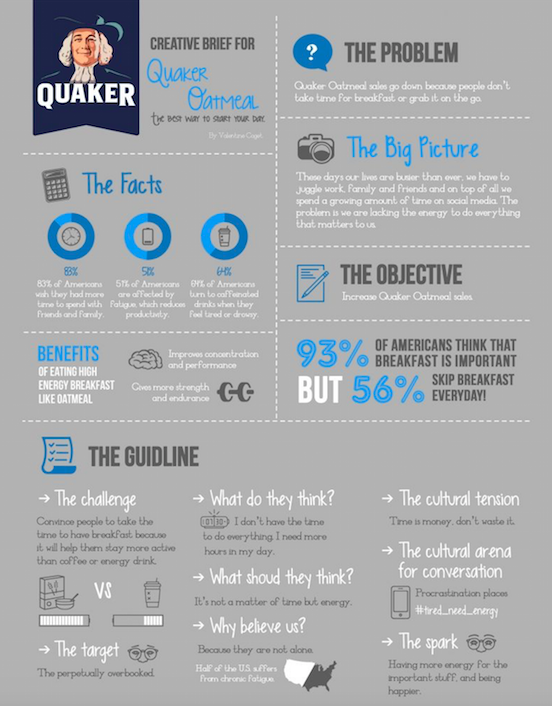Wie man ein kreatives Briefing schreibt
Richtig ausgeführt, hilft ein kreatives Briefing dabei, Ihre Werte, Ihre Vision und das gewünschte Endergebnis zu vermitteln. Lesen Sie weiter, um zu erfahren, wie Sie Ihr eigenes Briefing erstellen können und sehen Sie sich einige Beispiele an, damit Sie so schnell wie möglich loslegen können.

Ganz gleich, ob Sie mit einer externen Kreativagentur zusammenarbeiten oder eine eigene Agentur beauftragen, ein gemeinsames Briefing für eine Marketingkampagne stellt sicher, dass alle Beteiligten auf derselben Seite stehen. Denn wenn Sie Zeit und Geld in die Zusammenarbeit mit einer Agentur für eine gut durchgeführte Marketingkampagne investieren, möchten Sie sicher sein, dass Sie das Beste aus Ihrer Partnerschaft herausholen. Wenn Sie ein internes Team haben, wird es Ihnen dankbar sein, wenn Sie ihm genau sagen, was Sie wollen.
Schauen wir uns die Standardelemente an, die Sie einbeziehen sollten, zusammen mit einigen Beispielen.
Was ist der Zweck eines kreativen Briefings?
Ein kreatives Briefing dient als Vorlage für alle Ergebnisse, ganz gleich, ob Sie an werblichen Assets, einem Podcast oder visuellen Elementen für die sozialen Medien arbeiten - die Liste ist endlos.
Ein gut ausgearbeitetes Briefing hilft den Beteiligten zu verstehen, wie Sie sich das Projekt vorstellen, welches Publikum Sie erreichen wollen, welche Art von Ergebnissen Sie anstreben, welche Ziele Sie verfolgen und weitere wichtige Informationen. Wenn Sie sich nicht darüber im Klaren sind, wie Ihre Marke in Ihren kreativen Assets klingen und sich anfühlen soll, kann die Ausführung Ihrer Kampagne darunter leiden.
Beispiele für kreative Briefings und Elemente
Die meisten Briefings sehen relativ ähnlich aus. Wir haben daher ein Standardformat für Sie erstellt, damit Sie keine Details auslassen.
- Das Leitbild Ihres Unternehmens
- Eine Erläuterung des Projekts und wie sich diese Anfrage für kreative Leistungen in die Gesamtstrategie der Kampagne einfügt
- Informationen über die Zielgruppe, einschließlich der Märkte und Personas, die Sie ansprechen, sowie relevante demografische oder psychografische Profile
- Ihre "große Idee" oder das Ziel, das Sie mit den kreativen Leistungen zu erreichen hoffen
- Die Stimme und die Botschaften Ihrer Marke
- Ihre Konkurrenz und alle Herausforderungen oder Widerstände, mit denen Sie rechnen
- Logistische Details, einschließlich Ihres Budgets und des Zeitrahmens, in dem Sie das Projekt abschließen müssen
Ein kreatives Briefing besteht in der Regel aus einer einzigen Seite - maximal zwei Seiten - wie im Beispiel von PayPal unten gezeigt.
Im Folgenden finden Sie einen detaillierteren Überblick darüber, was alles enthalten sein sollte, sowie einige wichtige Tipps für die Erstellung eines hochwertigen Briefings.
Teil 1: Der Hintergrund Ihres Unternehmens
Sie möchten die Kernelemente Ihres Unternehmens vorstellen, damit eine externe Agentur Ihre Marke verstehen kann. Wenn Sie einen bestimmten Standpunkt oder eine Reihe von Werten haben oder sich an einer Mission orientieren, ist dies der Ort, an dem Sie dies vermitteln möchten. Natürlich kann dieser Teil weggelassen werden, wenn Sie mit einer internen Agentur zusammenarbeiten.
Teil 2: Ihr Projekt
Dieser Abschnitt hilft den Kreativen zu verstehen, was Sie von ihren Leistungen erwarten. Erläutern Sie zum Beispiel, ob Sie einen 30-Sekunden-Werbespot benötigen, um Ihre neueste Produkteinführung bekannt zu machen, einen sechswöchigen Podcast, um über die hochkarätigen Kunden zu berichten, die Sie engagiert haben, oder vielleicht eine neue Website, um Ihr Branding aufzufrischen.
Optimizely is a 8x Leader in CMPs!
Teil 3: Ihr Zielpublikum
Je mehr Sie über Ihre Zielgruppe wissen, desto besser kann Ihr Kreativteam Ihr Anliegen umsetzen. Hier geben Sie an, wen Sie mit dieser speziellen Kampagne ansprechen möchten und welche Details Sie über das Verhalten und die Wünsche der Zielgruppe wissen, die für eine effektive Umsetzung durch die Kreativen relevant sein können.
Teil 4: Ihr Ziel
Wollen Sie möglicherweise neue Kunden erreichen oder Ihre Marke auf eine andere Zielgruppe ausrichten? Wenn Sie den Kreativen Ihr gewünschtes Ergebnis mitteilen, können sie sich die effektivste Umsetzung vorstellen.
Teil 5: Ihre Stimme
Haben Sie einen bestimmten Tonfall, in dem Sie immer kommunizieren? Gibt es eine Botschaft, die Sie mit Nachdruck vermitteln wollen? Dies sollte Ihre Marke widerspiegeln und Ihre Zielgruppe ansprechen. So wie es Hasbro unter "Mandatories" getan hat.
Teil 6: Ihre Konkurrenz
Es ist kein Muss, Ihre Konkurrenz mit einzubeziehen, aber so kann Ihr Kreativteam sehen, mit wem Sie es zu tun haben, damit es Sie auf dem Markt eindeutig positionieren kann. Definieren Sie konkurrierende Unternehmen, Produkte oder sogar bestimmte Kampagnen - je nachdem, was am relevantesten ist.
Teil 7: Ihr Umfang
Zu guter Letzt sollten Sie genau angeben, was Sie suchen, welches Budget Ihnen zur Verfügung steht und welche Termine Sie einhalten müssen. Dies wird natürlich Teil eines größeren Gesprächs sein, aber die Bereitstellung dieser Informationen in einem kreativen Briefing kann Ihrem kreativen Partner helfen, sicherzustellen, dass sie sich einig sind - und dass Sie nicht zu viel ausgeben, wenn Sie eine externe Firma beauftragen.
Nächste Schritte
Ihr kreatives Briefing ist ein wesentlicher Bestandteil Ihres integrierten Marketingplans. Da Sie die Verbraucher mit einer kohärenten Botschaft über alle Ihre Marketingkanäle hinweg erreichen möchten, kann ein gut ausgearbeitetes kreatives Briefing dazu beitragen, dass die Botschaften in Ihrer gesamten Kampagne konsistent sind.



